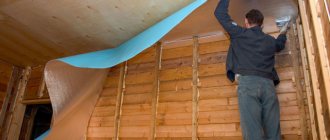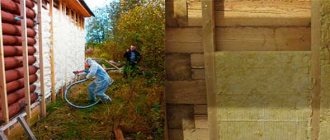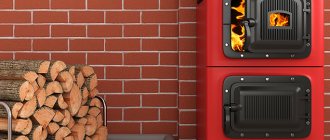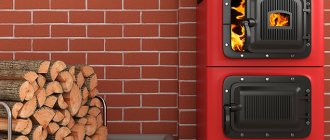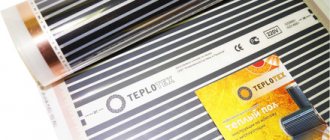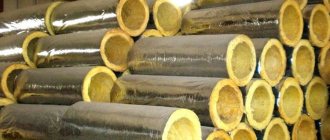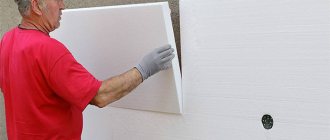Despite the Internet controversy that has flared up for a long time about the use of foil to retain heat in a bathhouse, the convictions of its supporters and opponents have not been shaken. However, the subject of dispute was initially the physical properties of the material, and in our time there are enough means to make “selection” - to strengthen the necessary properties of the material and weaken the unnecessary ones.
Look at the bathhouse and the mode of its use as a set of factors, each of which can be “for” or “against” insulation with this material. With this approach, harm and benefit cease to be absolute categories, as they are usually presented in disputes.
We will tell you how to place the foil correctly to achieve optimal results, but this will be discussed in other articles.
This article is devoted to the consideration of materials available on the market; both foil and foil bath insulation will be considered here.
Should I use foil for a bath?
As you already know, foil is used as insulation for rooms, mainly bathhouses. In most cases, the choice is made towards aluminum foil. The method of application and types of material are quite varied.
Of course, over such a long period of use, the material has acquired both its supporters and opponents.
- Opponents argue that since aluminum has high thermal conductivity, it does not retain heat. Thus, purchasing and equipping your premises with foil is a waste of effort and money.
- It is impossible not to agree with this opinion, except to slightly paraphrase: “Foil will not keep the room warm if you install it, ignoring all the rules!”
Of course, the foil will not show its properties if you attach it to a bare concrete, brick or foam concrete wall. The wall must be reinforced with a layer of insulation. Remember that foil can rebound heat, but not retain it without additional insulation materials.
By using this material you can save money on heating the room, since the foil will retain and accumulate heat in the heated room.
Bottom line
The process of insulating any room, including a bathhouse, is an important stage in the work. Not only the consumption of energy sources, but also the safety of building structures, as well as indoor comfort, depend on how well the work is done and how effective the materials are selected. Nowadays, materials for thermal insulation can be chosen from a huge number of products on the market. It is important to know that foil for insulating baths is an integral part of the process of creating optimal operating conditions in the future.
How to choose the right foil for a bath
Please note that purchased foil may not always fit well on certain surfaces, because of this you must know what little details you need to pay attention to and what criteria to use when choosing.
It must be said that the choice of material should be based on what kind of surface you have and the fastening method you choose.
Let's consider the basic criteria by which you can make a choice:
- Price - pay attention to this, since inexpensive options are most often not of good quality at all, but expensive ones often are. Therefore, to ensure that the foil is of high quality, choose a brand that is manufactured by one of the market leaders.
- Purpose is the most important criterion due to the fact that each material has its own type of foil. Of course, it is allowed to apply foil to any surface, but the service life will be significantly reduced.
- Foil on the crate is the most recommended option. The likelihood of damage to the foil in this case is significantly reduced.
- Environmentally friendly - choose only clean, natural rolls of foil that are not capable of releasing toxic substances when heated.
- Vapor permeability – no higher than 0.01 g/m² per day.
Foil without base
Quite thin material. This foil is used to insulate walls in warm rooms (mainly baths). It must be installed on a previously installed insulation layer.
The ends of the material are overlapped one on one, and the joint of the sheets is certainly glued using adhesive tape on a metallized base. This way you will create a completely sealed reflective layer of foil.
The limit of the reached temperature is +650°C. That is, foil can provide rapid heating of the room and maintain its temperature for a long time.
Foil without a base is considered resistant to damage and is not capable of releasing dangerous toxic elements when heated.
Advantages and disadvantages of the material
Foil usually always comes complete with another type of insulation. It is rational to install it in combination with glass wool and other denser materials. If these conditions are met, the material will have the following advantages:
- Vapor barrier and thermal insulation - thanks to this, hot steam does not pass into the middle of the insulating material, thereby preserving its properties, as well as the heat inside the room.
- Fire safety . The material can withstand high temperatures and is not flammable. Prevents fire from spreading to other walls.
- Possessing good soundproofing properties . Suppresses noise from the street and inside the steam room by almost 70%.
- Reducing the heating time of the bath . Thanks to properly equipped insulation of the internal walls, heat will quickly fill the steam room and be retained in it.
It is better to paste only with special tape. Ordinary tape will not withstand the weight of insulation PHOTO: potolok-exp.ru
Scheme of thermal insulation with foil in a bathhouse made of timber PHOTO: v-banyu.ru
Despite the large number of advantages, this material is not without disadvantages. These include:
- constant formation of condensation;
- you can’t do without ventilation equipment;
- air does not penetrate well, which can cause dampness and mold;
- poisonous properties of aluminum (this metal can glow in the body).
Proper care of the room and regular ventilation can reduce all the disadvantages to a minimum. Therefore, after each bath, you should not forget to open doors, windows and vents.
When insulating the ceiling, they try to use individual technology PHOTO: deluxemm.ru
Kraft foil
This type of material is produced on a paper basis. Comprises:
- Foil,
- Kraft paper,
- Polyethylene.
This material is quite durable, so you don't have to worry about it tearing while layering. Another distinctive feature is that it can be used without adding insulation.
- Moreover, foil based on craft paper is considered natural, that is, when heated, it also does not emit toxic substances and is considered safe for humans.
- Thickness: 0.03mm-1.0mm.
- Temperatures can reach one hundred degrees.
The ends of the material are overlapped one on one, and the joint of the sheets is certainly glued using adhesive tape on a metallized base.
This material is more convenient to use due to its base and increased strength properties.
Choosing the wood from which the lining is made
Before sheathing the inside of the bathhouse with clapboard, the owner of the room will have to decide on the type of material and wood. First, there are two types to choose from: regular lining and its Euro version. Finishers often prefer eurolining. The reason is the appropriate length of the groove and a wide ridge, which ensures a tighter fit of the elements than when working with ordinary lining. The eurolining is also equipped with holes for ventilation. Their task is to protect the material from the formation of condensation and subsequent deformation. The service life of such lining is many times longer than that of a conventional one, since the highest grade wood is used for its manufacture.
The finishing of the bathhouse with clapboard is carried out taking into account the specifics of the room - high levels of humidity, temperature changes. These factors are taken into account when selecting wood. Species that release resin when heated are not suitable for this, including most coniferous trees.
The following types of wood are suitable for finishing baths:
- Alder. Hygroscopic wood with low thermal conductivity. Used for interior decoration in country houses and baths. In addition to the pleasant aroma, the fumes it produces have a beneficial effect on human health. Medium price material. Sold in pieces up to 3 m in length.
- Oak. This wood is elite and one of the most expensive. Its advantage is that the oak panel does not require additional processing or protective coatings. Oak wood is also considered eternal - the finish will last for decades even with regular use of the steam room, since such wood does not rot. African oak, abash, has similar properties. Its only difference from the usual one is its light brown color and less processing complexity.
- Aspen. The wood is soft and easy to work with. Over time, its strength increases, the material tolerates high humidity and temperature changes without consequences. The only drawback of aspen lining is that over time its surface becomes dull. To return it to its original appearance, you will have to sand the outer surface of the lining with fine-grained sandpaper.
- Linden. The material not only looks beautiful and is easy to process, but also emits beneficial fumes when heated. Therefore, linden is one of the traditional materials for finishing both the dressing room and the steam room. The wood is light, with a reddish or brown tint, does not dry out due to changes in humidity and has its own matte shine. The only drawback is the oxidation of iron when interacting with such lining. Metal parts in the steam room or dressing room will have to be coated with special compounds, or their use will have to be abandoned.
- Cedar. Durable wood in shades from beige to coffee, the color depends on the region where the wood grows. Expensive and resistant to changes in temperature and humidity, it needs to be treated with an antiseptic before use as a finishing material. The disadvantage of cedar lining is the risk that over time the finish will begin to release resin without heating the room.
- Larch. Coniferous wood with antiseptic properties. Lining made from it becomes stronger when used in rooms with high humidity. Lining is in demand, found everywhere, its price is an order of magnitude lower than that of other types of coniferous species suitable for installation in a steam room.
- Hemlock. The second name of the tree is Canadian hemlock. It is resistant to temperature changes and increased humidity, and is also much higher in mechanical strength than pine. Like cedar and linden, it releases essential oils beneficial to human health when the room is heated.
Pine is used with reservation. You have to be careful when finishing the inside of the bathhouse with it - the wood releases resin when heated. This substance stains things and sticks skin to wooden surfaces. Can cause burns if heated too much. Therefore, only the dressing room and dressing room are upholstered with pine clapboard, choosing other types of wood for the steam room.
Folgoizolon
This foil is polyethylene foam with foil as a cover.
- You can find it in stores in roll or sheet form. Depending on what thickness of the product you personally need.
- The product has high strength, shock absorption and sound insulation characteristics.
- This fact means that it can be laid on the surface without additional insulation.
- Most often it is used as insulation for wooden surfaces.
It is also worth noting that the material cannot be deformed.
Megaflex
This is bath foil that has higher quality parameters compared to its competitors. Megaflex can be used at temperatures above 300 degrees. Bath foil is highly reflective. If the installation technology is followed, this product will help create a sufficiently sealed system, which prevents the spread of steam outside the bathhouse.
PIR boards
These slabs are ideal for insulating saunas and baths. The inside of the slabs is porous, but the cells inside are closed, which is why they do not absorb water.
- This is the most important indicator that you should pay attention to when choosing insulation for baths and saunas, where humidity will always be present.
- The stove is able to withstand large temperature changes without emitting toxic substances. PIR boards are used to insulate various surfaces: walls, ceilings or floors.
There are many types of slab coatings, but aluminum foil is the most popular.
This type of insulation is a strong barrier not only to heat, but also to vapors emanating from water. In addition, you can save on heating the room. By heating it once, you will not have to frequently add firewood to the stove or increase the heating time of the boiler.
Covering installation
To ensure the most effective and high-quality coating and ensure a comfortable stay in the steam room, you should follow a number of tips when laying the material.
- When laying foil materials in steam rooms of non-commercial baths and saunas, it is sufficient to use rolled or kraft foil with a thickness of at least 3 mm.
- For large steam rooms, foil on a mineral or basalt base is suitable.
- When locating a bathhouse inside a house or in a basement, it is important to take into account central heating and the location of its sources, if possible using it for additional heating of the steam room air.
- Before starting work, it is necessary to provide for the removal of condensate by making a small withdrawal of the canvas from the ceiling to the walls, as well as from the walls to the floor. To do this, the foil material is laid with an overlap of 15-20 cm and taped with foil tape.
Important! To create a “thermos” effect, a gap of 13-18 mm must be left between the layer of foil coating and the finishing to ensure ventilation and maintain a healthy microclimate.
A gap of 1-2 cm will allow the condensate to dry out during the period between heating the bath. Ventilation gap on the ceiling
The installation process of foil occurs in several stages; the most convenient to use are rolls or sheets 60 cm or 1.2 m wide.
- The walls of the steam room need to be lathed with beams with a cross-section of 5x5 cm. The distance between adjacent planks depends on the width of the material.
For rolls of 600 and 1200 mm it is 60 cm, for foil materials with a width of 1000 mm and 1500 mm - 50 cm. The bars are fastened with self-tapping screws of a suitable length. Sheathing Fastening the sheathing beams to the ceiling Fastening the sheathing beams to the floor - A layer of mineral insulation is laid between the slats so that it does not protrude beyond the level of the beams.
Measuring the distance between the sheathing beams. Fastening insulation boards to the ceiling. The photo shows the use of foil insulation. The insulation board is tightly inserted between the sheathing bars. For internal walls, you can use 50 mm thick insulation. For external use, a 100 mm slab is suitable or it is possible to lay 50 mm thick slabs in two layers - A foil material is fixed on top of the insulation layer with the obligatory placement of a reflective layer inside the steam room. The joints of adjacent canvases or sheets can be glued with metal tape, but it should be remembered that under the influence of high temperatures the glue can soften and the panels will separate, breaking the tightness.
Fixing the foil with tapeIt is best to fix the foil with staples or nails, nailing them directly onto the beams. If the width is large, the foil material is fixed not only at the edges, but also in the middle.
- The laid foil is sewn up with clapboard, leaving a one and a half centimeter air pocket, the main function of which is to reduce the thermal conductivity properties of the foil layer and to maximize the reflection of all the rays that hit the foil back into the steam room.
An air pocket will allow you to create a sheathing for the lining. Choose planks 10-20 mm thick and fix them with self-tapping screws. Fastening the sheathing under the lining Installation of the lining Cladding wall and ceiling
Sometimes the order of arrangement of materials can be changed - a layer of foil is stuffed onto the insulation layer placed between the sheathing bars, staples or nails, which is fixed on top with thin slats placed strictly on top of the sheathing with self-tapping screws of sufficient length.
Bathroom wall decoration
In some cases, wooden sheathing can be placed on top of the insulation layer, laying foil over the entire area of the walls, including. and on the uneven bars. Then it is impractical to leave air pockets, and the lining is fixed directly on the sheathing. But, as practice shows, purchasing combined heat-insulating materials with a layer of foil is not only more economically profitable, but also significantly simplifies the entire installation process.
Fastening the sheathing to aerated concrete walls It is correct to attach the block to the concrete walls through spacers 2-3 mm thick in order to leave a ventilation gap. We align the bars according to the level. For fastening self-tapping screws to walls made of aerated concrete, ordinary nylon dowels No. 6 are suitable. Water supply pipes pass under the clapboard sheathing. When installing the sheathing avoid contact with the floor The deviation from the unprotected steel chimney when passing through the ceiling must be at least 50 cm Installation of foil on top of the insulation Fastening the lining
Video - How to properly decorate a steam room in a bathhouse
Arranging steam rooms using foil materials allows you to save 25-30% on heating raw materials for stoves, as well as extend the service life of the structure, preventing the development of fungi, mold and microorganisms harmful to humans.
